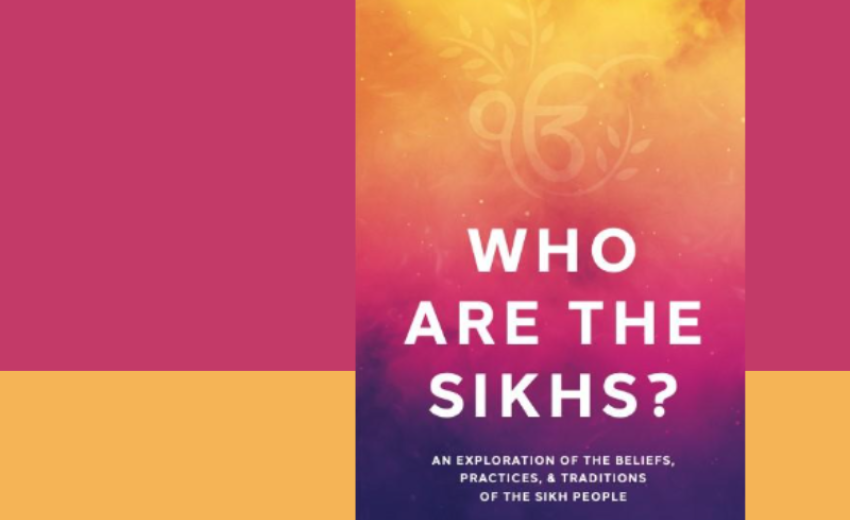Title of Book: WHO ARE THE SIKHS?
Authored by: Gian Singh Sandhu, Surrey, Vancouver, BC, Canada
Published by: ARCHWAY Publishing, Pages: 375, Price: US $24.99.
Reviewed by: Prof. Hardev Singh Virk, Professor of Eminence (Honorary), SGGS World University, Fatehgarh Sahib (Punjab)
I encountered Gian Singh Sandhu in a Seminar organised by him in 2018 on Sikhism at Surrey Campus of Simon Fraser University, Vancouver. It was well planned and well attended. After the seminar, I was offered a copy of his recently published book, “An Uncommon Road: How Canadian Sikhs Struggled Out of the Fringes and into the Mainstream”. It was a comprehensive biography of Gian Sandhu which highlights the plight of Indian immigrants who arrived in Canada for ameliorating their economic conditions.
The book under review is his second attempt to enter world of academia. It deals with an important theme of Sikhi (Sikhism). Guru Nanak was the Founder of Sikhi, and his followers are known as Sikhs, which literally means learners. The Tile page addresses the question, “Who Are The Sikhs”? This question has been answered by many authors in the form of Pamphlets and Monographs. But all earlier attempts fall short of the approach adopted by the author. He has covered all the possible themes under the sky about Sikhi and tries to answer all type of queries raised by seekers of knowledge about this youngest religious tradition of India. He is justified to give a sub-title to his masterpiece: “An Exploration of the Beliefs, Practices, and Traditions of the Sikh People”.
The book is dedicated to Sri Guru Granth Sahib, the eternal Guru, for spiritual wisdom and guidance. Professor Dharam Singh, Former head of Encyclopaedia of Sikhism, Punjabi University, Patiala writes in his Foreword: “The author has prepared a detailed list of questions and put them under different headings and Chapters. These questions relate to Sikh metaphysics, philosophy, history, social thought, tradition, institutions, beliefs, practices, and so on”. In his Preface, Gian Singh narrates an interesting story which became motivation for writing this book. He gives some tips for reading this book and a note about terminology used. He remains humble in his claim: “My goal of writing this book is not to provide an academic treatise on Sikhism but to familiarise the readers with the Sikh worldview”.
The book has been meticulously designed by the author by organising the textual material in VIII Sections, each section divided into Chapters with appropriate headings. Sections follow a sequence starting from evolution of Sikhi and ending with the Sikh Psyche. The first question starts with “When was Sikhi founded” and the last one ends with “Do We Walk the Talks”? Author has answered 261 Questions on SIKHI using all published and unpublished documents available to him. The range of Questions and Answers is mind-boggling.
Question 1: “When was Sikhi founded?” sets the tone for forthcoming questions. In one para, reader gets authentic information about foundation of Sikhi by Guru Nanak and passing his mantle of Guru-ship to ten Gurus in person and then on to Sri Guru Granth Sahib as eternal Shabd Guru for the Sikhs. The questions that follow define Sikhi as a new religion and its basic tenets. Chapter 3 “A Spiritual Revolution” is an important milestone in this book. The reader gets to know about Guru Nanak, the founder of Sikhi and other Sikh Gurus. The author refers to the historical blunder made by Sikh leadership during Partition of India. But it is difficult to digest his statement on the basis of Partition Documents released after 50 years of Partition: “Sikhs were given the option of their own independent state by the British in 1947.”
Section II discusses the Identity of a Sikh from all aspects. According to author “Sikhs are a nation by all means”. The Sikhs are classified into different categories, for example, amritdhari Sikh, kesdhari Sikh, sahajdhari Sikh, mona Sikh, gora Sikh, sanatan Sikh, etc. “Becoming a Sikh” is a valuable Chapter answering 17 questions about Sikhi. In Chapter 8, dietary habits and food practices are included. According to author: “Fasting has no religious merit for Sikhs. Sikhs believe that the human body is a gift from the Creator.”
As a reviewer, I must leapfrog to other Sections to finish it in given time and space. I wonder author has no inhibition in answering questions related to gender, dating and sexuality. Sections on Art, Music, Culture, Creator, Creation, Beliefs are equally challenging, but author has done full justice to clarify the doubts.
Chapter 14 is devoted to Sikhi concept of Waheguru (God). In author’s view, the central focus of Sikhi is spiritual enlightenment to know and merge with the divine source of all creation, called Waheguru in Sikhi. Sikh scripture starts with Ik-Ongkaar, the symbol or logo which best represents the qualities of God as “One Supreme Reality that permeates the whole Universe”. Author tries to answer some tedious questions about God, for example, Is Waheguru (God) male or female? How can you find Waheguru? Where does Waheguru dwell? The last question has been elaborately discussed with reference to experimental studies carried out by neuroscientists. However, for the Sikhs, the existence of Universe itself is the evidence of the existence of Waheguru (God). All answers are fortified by the author using Gurbani quotes from Sri Guru Granth Sahib, which is the beauty of his narrative.
Chapter 15 “The Role of the Guru” contains 21 questions and their answers. It is most significant for a Sikh as well as for non-Sikhs who want to understand the role of Guru in Sikhi. The first question is “What is a Guru in the Sikh faith” and the last “What is Dasam Granth”. Guru means “deliverer or liberator from darkness”. The role of Sikh Gurus is defined: “They taught how to move from darkness to light, from ignorance to enlightenment, from fear to confidence, from hate to love, and from despair to joy”. The relation between Guru and God (Waheguru) is explained. Sabad Guru is the Guru in Sikhi. “What is Sri Guru Granth Sahib” elaborates the history of compilation and its installation in the Darbar Sahib (Golden Temple). “What is Dasam Granth” tries to answer queries about its composition and ongoing controversies among the Sikhs. It is part of Sikh literature but can not be equated with Sri Guru Granth Sahib, eternal living Guru of the Sikhs.
Chapter on “Universe and Creation” explains creation, evolution, environment, heaven and hell as understood on the basis of Sikh scripture. Chapter 17 answers 21 questions pertaining to life of a Sikh from birth to death. The author has a flexible approach to cycle of death and birth, known as transmigration, He does not follow a rigid approach in answering these questions. Part VI has three Chapters (18-20) covering a vast range of Sikh beliefs. It answers questions pertaining to salvation, miracles, angels, devil, ghosts, yugas, freewill, ego, sin, compassion, guilt, and many more concerning the Sikh faith. The Sikh society has developed its own rituals and customs vis a vis Hindu society.
Part VII has three Chapters (21-23) dealing with “Organisation of Sikh Institutions and Administration”. Its major concern is Gurdwara administration and religious ceremonies. Gurdwara is a fulcrum of Sikh religious and social life, especially for diaspora Sikhs. The purpose of Sikh symbols used in Gurdwaras, and significance of Sikh prayer (Ardaas) is explained by the author.
Part VIII “Sikh Psyche” has four Chapters (24-27) dealing with Sikh aspirations as a nation. Before answering the question, “What is Khalistan?”, author goes into the historical background of this issue and then replies: “Khalistan is an ideal name given to an independent Sikh state some Sikhs want to reclaim from India”. At the end of this discussion, he poses another question: Does Khalistan still matter? And answers himself: “To many, it does – and this remains an issue that must be decided by those most affected by the change it would augur: the people of Punjab”. In the last Chapter, author refers to both internal and external challenges to Sikhi. He is aware of political scenario in India and at global level.
As a reviewer, it is my duty to point out if there are any discrepancies in the narrative. A selected Glossary of Panjabi terms used in the book, with their equivalents in English, is added for convenience of readers. An exhaustive Bibliography is also given at the end followed by index. However, minor mistakes are found in Part I. On page 8, citation 5, there is a mismatch between Roman text and Gurbani quote in Gurmukhi (SGGS, 51). The same mismatch on page 9, citation 6. On page 11, last line, Nankana Sahib is listed under East Punjab. I did not bother to point out mistakes in other sections of the book as it is very time-consuming exercise. I suggest author may get it checked up by an expert in theology.
The special feature of this volume is use of Gurbani quotes to justify the answers. This approach makes the narrative authentic. The author has relied upon published and other resources, including personal discussion, concerning Sikh religion. I am astonished at his accomplishment in writing this monumental work covering a wide spectrum of Sikh issues in the form of questions and answers. He claims that writing became a passion a little late in his life and he took it as a challenge. In my opinion, he has won this challenge and come out successful. Gian Singh Sandhu deserves all praise for bringing out this volume for the education of our own Sikh and non-Sikh persona about the Sikhi at global level.





